Cat Care and Grooming
Cat care and grooming go hand-in-hand. Grooming your cat not only helps to keep your cat's coat in good condition, but it is a perfect way for you and your cat to strengthen your bond.
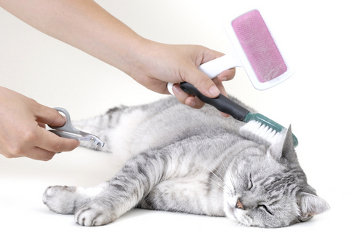
What kind of grooming tools you will need depends on the type of coat that your cat has. The condition, coat length and coat thickness all play a part in choosing the grooming tools.
Cat care and grooming: When to groom
Longhair cats ideally need a daily grooming session whereas short-haired cats only require a brushing once a week.
The more often you groom, the easier it will be to keep the cat's coat in perfect condition.
You must pick the right time for grooming - do not wake your cat up to do this and do not force the cat to be groomed.
Start grooming your cat from kitten-hood as this will get him used to being handled and brushed.
Reward your cat with a tiny morsel of tuna or a favorite food every time he accepts being groomed.
Cat care and grooming:
Why should you groom your cat?
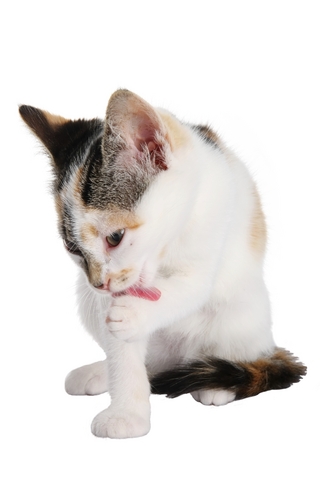
Cats can spend an enormous amount of time grooming themselves.
Most of the time they do a pretty good job, but sometimes they need a little assistance from us.
Long-haired cats need daily grooming to ensure that their coats do not become dull, matted and tangled.
Grooming also helps you to spot nasty critters such as ticks and fleas, and any skin conditions that might be hidden by thick fur.
You can also remove any litter that might have clumped between the cat's toes and so save it from walking uncomfortably.
Regularly grooming your cat also helps you if you suffer from pet allergies as any loose hair will be eliminated before it can land on sofas, beds or clothes.
Cat care and grooming: Grooming short-haired cats
You can use your hand as a grooming tool to loosen and remove any dead hair.
A grooming glove is ideal for short hair cats.
You simply put the glove on and rub it over the cat's body. This is also soothing for your cat.
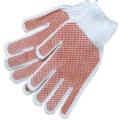
You can also use a moderately stiff brush to brush the coat lightly from head to tail to remove loose hair, or use a rubber grooming tool that gently removes loose hair and massages your cat.
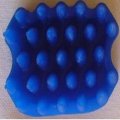
Next, you can use a fine-toothed comb all over to remove any dirt and grit and any parasites.
Use moistened cotton wool and wipe around your cat's eyes, nose and under the tail, using a new piece of cotton wool each time.
If the inside of the ear flap is dirty, use a piece of cotton wool moistened with baby oil to gently clean wax and dirt. NEVER use a cotton bud or poke anything into the ear canal.
Cat care and grooming: Grooming long-haired cats
Ensure that you have the right tools so that cat care and grooming becomes a simple, enjoyable task.
Start by brushing the back first. Brush in the direction that the hair is lying, working from the head down to the tail.
Grooming powder is available for soft coats that are prone to matting and tangling. This powder soaks up excess oils and separates the hair, making it easier to brush.
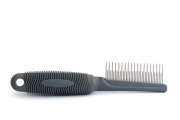
Comb out any loose hair but do not pull at any knots as this is painful for the cat.
Take the knotted piece of hair in your hand and gently tease out the knots.
Gently brush the tummy with a soft bristle brush and use a soft brush on the tail area as this part is very sensitive.
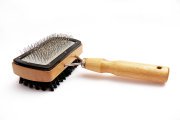
Moisten cotton wool with lukewarm water and gently wipe around the eye and nose areas, using a new piece of cotton wool for each eye and the nose.
Very gently wipe under the tail with another piece of cotton wool.
A soft human toothbrush is ideal for grooming the facial area. Finish of the grooming session with a grooming pad that will leave the coat silky and shiny.
Cat care and grooming: Furballs
A furball or a hairball is an accumulation of hair in your cat's stomach. This occurs as a result of your cat grooming himself.
A cat's tongue has backward-facing spines that work much like a comb. The cat will swallow any loose hair.
A solid mass of hair forms that will rub against the lining of the stomach and because of this irritation, your cat will vomit the furball up. Cats often eat grass that act as an emetic which helps them to vomit furballs up.
If the furball lodges further down the digestive tract, it might cause a blockage - should you notice that your cat has a decreased appetite and constipation, you need to seek veterinary assistance.
All cats produce furballs and grooming your cat regularly will prevent problems.
Cat care and grooming: Bathing a cat
Cats usually do not need a bath and most cats have an aversion to water and getting wet.
You should only bath your cat if it is really necessary, and if you are unsure of how to do this, take your cat to a grooming parlor or cattery where experienced people can do it.
Only bath your cat if you are preparing for a show, if your cat has managed to get itself very dirty or covered in some chemical, or if your cat needs to be bathed with a special shampoo for veterinary reasons.
Following these guidelines will help to make the task easier for both of you:
- Always use a shampoo specially formulated for cats. Never use your own human shampoo.
- Get someone to help you restrain the cat so that you can use both hands to do the washing.
- Bathing your cat in the kitchen is easiest. Fill the sink half-full with lukewarm water (never hot water!) and place your cat in the water.
- Saturate the fur with water. Wet the face with your wet hand.
- Massage in the shampoo, being very careful not to get any near the cat's head.
- Carefully rinse the coat until no shampoo residue remains. You will probably have to fill the sink with clean water 2-3 times.
- Gently rub the cat dry with a warm towel and leave the cat in a warm room or by a sunny spot to finish drying off. Once the coat is dry, brush it to untangle and smooth the coat.
- Never use human shampoo as it contains chemicals that can be harmful for your cat.
- Choose a shampoo that has an added conditioner. This will make the task much shorter and will also prevent the coat from becoming too tangled.
- Cat wipes (similar to baby wipes) are available from pet supply stores if you need to clean your cat but do not want to traumatize either of you by bathing your cat. Dry shampoo's that are sprayed on and brushed out are also available from pet supply stores.
- Bathing your cat will be a much easier task if you get your cat used to it from kitten-hood, especially if your cat is a show cat.
Cat care and grooming: Dental hygiene

You can help to prevent tooth decay, gum disease and bad breath by regularly cleaning your cat's teeth.
Start when it is still a kitten, as trying to clean an adult cat's teeth is a near impossible task.
You can start by just putting the brush in the kitten's mouth for a few seconds. Talk to your kitten in a soothing tone and reward him with a tasty morsel afterward.
Do this every day until your kitten is no longer bothered by the object in his mouth. You can then introduce a feline toothpaste.
Toothbrushes specifically designed for kittens and cats are available from your vet or from pet supply stores. NEVER use human toothpaste - special gels, paste or oral rinses are available from your vet or pet supply store.
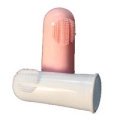
Toothbrushes that fit on the tip of your index finger is a good idea.
Cat care and grooming: Trimming claws
Trimming a cat's claw is basically just snipping off the sharp, dead tip of the claw and this should be part of your cat care and grooming routine, especially if your cat is an indoor cat.
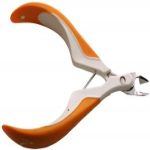
The best tool for this is a guillotine-style clipper as pictured.
- Start when your cat is relaxed. If your cat tends to squirm, ask someone to assist you so that you can concentrate on the paw.
- Talk soothingly to your cat whilst gently pressing on the top of the paw behind the toes which will extend the claws.
- The dead part of the claw is white to brown in color (this is what you want to trim) and the living quick (the part you do NOT want to cut into) will be pink in color.
- Putting the clipper over the dead tip of the claw, gently cut straight across, rather cutting of too little than too much.
- When finished, make sure that you give a food treat as this will enforce that trimming claws is a good thing.
NB! Trimming claws is not the same as declawing! Declawing a cat is a cruel and painful procedure that no responsible, loving owner should ever consider.
Having a cat declawed is basically the same as removing the first joint from your fingers - the last bone of the cat's claw/toe is removed.
The recovery period is extremely painful for the cat and walking, jumping and scratching in a litter box becomes an ordeal.
Unfortunately, the pain does not go away - the cat will always have discomfort when walking as a result of this procedure.
If furniture scratching is an issue, invest in a good scratching and climbing post for your cat.
This gives him an opportunity not only to shed the outer layer of the claw, but it also provides excellent excercise.







